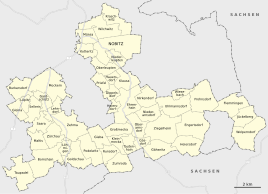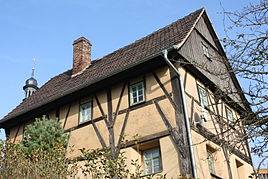Gieba
|
Gieba
community Nobitz
Coordinates: 50 ° 54 ′ 52 ″ N , 12 ° 28 ′ 38 ″ E
|
|
|---|---|
| Height : | 221–241 m above sea level NN |
| Area : | 1.68 km² |
| Residents : | 67 |
| Population density : | 40 inhabitants / km² |
| Incorporation : | July 1, 1950 |
| Incorporated into: | Podelwitz |
| Postal code : | 04603 |
| Area code : | 034493 |
|
Districts of the unified municipality Nobitz
|
|
|
West side of the post structure
|
|
Gieba is a district of the Thuringian community Nobitz in the Altenburger Land district . Before that it belonged to the municipality of Podelwitz and the municipality of Saara . Above all, the oldest half-timbered house in the Altenburger Land is known.
location
The village is located about eight kilometers (as the crow flies) south-southwest of the district town of Altenburg and about four kilometers southeast of Saara and also four kilometers northeast of the nearest town of Gößnitz .
Adjacent places are clockwise north the locality Mockzig of the district Ehrenberg of the city Altenburg, Großmecka in the east, Runsdorf south and Podelwitz west.
history
Gieba was founded as a Slavic clearing settlement and is still a reminder today. The place was first mentioned in documents around 1200 as Chiowe, around 50 years later as Kyowe or Kybwa. The place name comes from the old Sorbian Kyi, which means something like stick. Records from 1445 testify that the place then consisted of 12 farms. In 1525 "Kybaw" apparently belonged to the gentlemen von Ende , because the tortured and mutilated sexton Georg Droßdorf, who had been expelled from Ponitz , asked the Saxon Elector Johann the Constant for his help, here or in Fuchshayn (with the gentlemen from Ende) received: “I ask E. Kfl. G. to give me guidance and protection and to marry me from the end umb den dinst to Fuchshayn or to Kybaw [Gieba near Altenburg] ... “Gieba belonged to the Wettin office of Altenburg , which from the 16th century onwards due to several divisions In the course of its existence it was under the sovereignty of the following Ernestine duchies : Duchy of Saxony (1554 to 1572), Duchy of Saxony-Weimar (1572 to 1603), Duchy of Saxony-Altenburg (1603 to 1672), Duchy of Saxony-Gotha-Altenburg (1672 to 1826) ). When the Ernestine duchies were reorganized in 1826, the place came back to the duchy of Saxony-Altenburg. After the administrative reform in the duchy, it belonged to the eastern district (until 1900) and to the Altenburg district office (from 1900). From 1918 the village belonged to the Free State of Saxony-Altenburg , which was added to the State of Thuringia in 1920. In 1922 it came to the district of Altenburg . In 1837 127 people lived in the place, about 100 years later, in 1939 there were 134, 12 less than six years earlier.
On July 1, 1950, Gieba was incorporated into Podelwitz . During the second district reform in the GDR in 1952, the existing states were dissolved and the districts were redesigned. Thus Gieba came as a district of the municipality Podelwitz with the district Schmölln to the district Leipzig , which since 1990 belonged as district Schmölln to Thuringia and 1994 in the district Altenburger Land. The village pond was used as a landfill in GDR times and so it was recultivated by the Schmöllner Verein naterger eV Also in GDR times, an LPG with young cattle facility was founded, which still exists today. When the municipality Podelwitz became part of the unified municipality of Saara , Gieba became a part of this municipality on January 1, 1996, until it came to Nobitz on December 31, 2012.
Culture and sights
Gieba owns a medium-sized baroque church from 1729, which comes from the builder Küntzel from Taltitz / Vogtland. It houses grave monuments from the years after 1585 for the von Rußwurm family. As a special feature, there is a side tower to the south of the nave. The church has three bells from 1463 and 1718, which were renewed in 1995.
There is a legend about the history of the church bell, according to which the bell itself mystically disappeared during the looting of the Hussites in 1430 and was only found again by a pig.
The place is also known far beyond the district boundaries because of the oldest preserved post structure in the Altenburger Land district. It was built in 1564 and 1565 and verified by a dendrochronological building age study. The compartment of the building is 2.80 meters wide and consists of continuous posts from the threshold to the roof beam, and the headbands resemble a tree of life.
Web links
Individual evidence
- ↑ Steffen Winkler : The case of the sexton from Ponitz . In: Special edition series (legends and legendary stories from Glauchau and the surrounding area), Museum and Art Collection Schloss Hinterglauchau, Glauchau, 1981, GDR, p. 10 and 31
- ^ The Altenburg Office in the book "Geography for all Stands", from p. 201
- ^ The locations of the Altenburg district from p. 83
- ↑ The eastern district of the Duchy of Saxony-Altenburg in the municipal directory 1900
- ^ The Altenburg district office in the municipality register 1900
- ^ State and address manual of the Duchy of Saxony-Altenburg, page 95
- ^ Michael Rademacher: German administrative history from the unification of the empire in 1871 to the reunification in 1990. altenburg.html. (Online material for the dissertation, Osnabrück 2006).
- ↑ Gieba on gov.genealogy.net
- ↑ natergerev.de
- ^ Georg Piltz art guide through the GDR , publishing house for popular science literature, Leipzig 1969
- ↑ Gieba on the website of the municipality of Nobitz (further information, e.g. about the legend of the bell). Accessed on January 21, 2016
- ^ Andreas Klöppel, Dieter Salamon: Altenburger Vierseithöfe - Landbaukunst in the granary of Thuringia. IGB, Lilienthal 2008, ISBN 978-3-9810618-3-3


